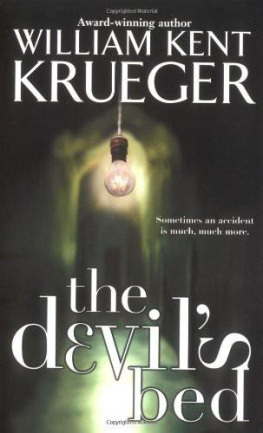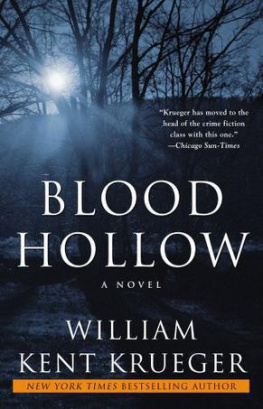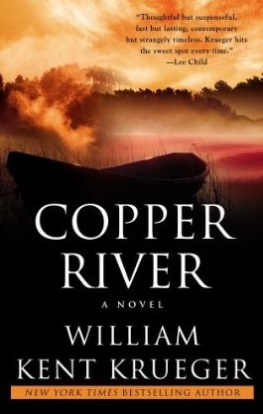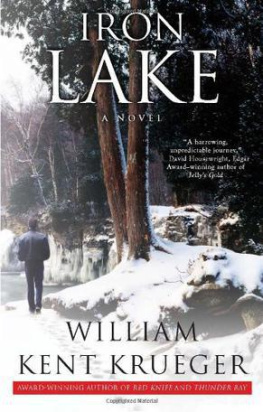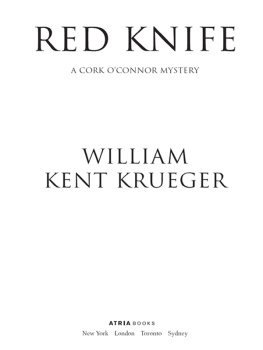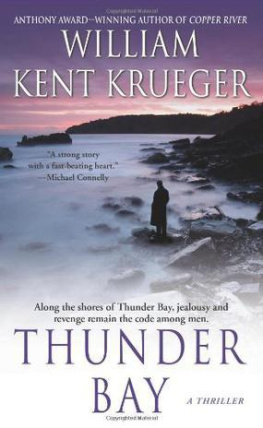VERMILION DRIFT
ALSO BY WILLIAM KENT KRUEGER
Heavens Keep
Red Knife
Thunder Bay
Copper River
Mercy Falls
Blood Hollow
The Devils Bed
Purgatory Ridge
Boundary Waters
Iron Lake

A Division of Simon & Schuster, Inc.
1230 Avenue of the Americas
New York, NY 10020
www.SimonandSchuster.com
This book is a work of fiction. Names, characters, places, and incidents either are products of the authors imagination or are used fictitiously. Any resemblance to actual events or locales or persons, living or dead, is entirely coincidental.
Copyright 2010 by William Kent Krueger
All rights reserved, including the right to reproduce this book or portions thereof in any form whatsoever. For information address Atria Books Subsidiary Rights Department, 1230 Avenue of the Americas, New York, NY 10020.
First Atria Books hardcover edition September 2010
ATRIA BOOKS and colophon are trademarks of Simon & Schuster, Inc.
For information about special discounts for bulk purchases, please contact Simon & Schuster Special Sales at 1-866-506-1949 or business@simonandschuster.com.
The Simon & Schuster Speakers Bureau can bring authors to your live event. For more information or to book an event contact the Simon & Schuster Speakers Bureau at 1-866-248-3049 or visit our website at www.simonspeakers.com.
Designed by Davina Mock-Maniscalco
Manufactured in the United States of America
10 9 8 7 6 5 4 3 2 1
Library of Congress Cataloging-in-Publication Data
Krueger, William Kent.
Vermilion Drift : a novel / by William Kent Krueger. 1st Atria Books hardcover ed.
p. cm.
1. OConnor, Cork (Fictitious character)Fiction. 2. Private investigatorsMinnesotaFiction. 3. MurderInvestigationFiction. 4. Cold cases (Criminal investigation)Fiction. 5. MinnesotaFiction. I. Title.
PS3561.R766V47 2010
813'.54dc22
2010013258
ISBN 978-1-4391-5384-0
ISBN 978-1-4391-7215-5 (ebook)
For Sarah Branham, my champion
In terms of the despiritualization of the universe, the
mental process works so that it becomes virtuous to
destroy the planet.
Russell Means
ACKNOWLEDGMENTS

The Vermilion One Mine and the Ladyslipper Mine, which appear in this work, are fictitious. There are, however, real mines that are very similar in their design, scope, and history, and Ive used elements of these actual places in the construction of this story. But I want to stress to anyone familiar with the remarkable area we call the Iron Range that I have taken liberties with fact in both geography and geology.
Im extremely grateful to James Pointer of the Soudan Underground Mine State Park for the gift of his time and his knowledge. The morning I spent with him half a mile underground continues to be a remarkable memory for me. Ive done my best to give readers the same sense of admiration that he gave me for the enterprise of the men who spent their lives working in near dark conditions to wrest iron from the earth. If youre ever in northern Minnesota, I cant recommend highly enough a tour of the Soudan Mine, which is operated by the state of Minnesota. I guarantee youll never take fresh air and sunlight for granted again.
I also want to thank the staff of the Minnesota Discovery Center (formerly known as Ironworld), particularly those in the Research Center, who helped me locate a wealth of information in the archives. This resource is invaluable to all of us for a continued understanding and appreciation of the rich culture and history of the Iron Range.
Im indebted to Dr. Garry Peterson, Chief Medical Examiner Emeritus of Hennepin County, Minnesota, for his help in understanding death, its aftermath, and the clues that bodies, no matter how ancient, can offer in unraveling the mystery of murder.
Finally, for their warm hospitality, a big thanks to all the staff at the wonderful little coffee shop called The Java Train, where the bulk of this novel was written.
VERMILION DRIFT
PROLOGUE

Some nights, Corcoran OConnor dreams his fathers death.
Although the dream differs in the details, it always follows the same general pattern: His father falls from a great height. Sometimes he stumbles backward over a precipice, his face an explosion of surprise. Or hes climbing a high, flat face of rock and, just as he reaches for the top, loses his grip and, in falling, appears both perplexed and angry. Or he steps into an empty elevator shaft, expecting a floor that is not there, and looks skyward with astonishment as the darkness swallows him.
In the dream Cork is always a boy. Hes always very near and reaches out to save his father, but his arm is too short, his hand too small. Always, his father is lost to him, and Cork stands alone and heartbroken.
If that was all of it, if that was the end of the nightmare, it probably wouldnt haunt him in quite the way that it does. But the true end is a horrific vision that jars Cork awake every time. In the dream, he relives the dream, and in that dream revisited something changes. Not only is he near his father as the end occurs but he also stands outside the dream watching it unfold, a distanced witness to himself and to all that unfolds. And what he sees from that uninvolved perspective delivers a horrible shock. For his hand, in reaching out, not only fails to save his father. It is his small hand, in fact, that shoves him to his death.
ONE

That early June day began with one of the worst wounds Cork OConnor had ever seen. It was nearly three miles long, a mile wide, and more than five hundred feet deep. It bled iron.
From behind the window glass of the fourth-floor conference room in the Great North Mining Companys office complex, Cork looked down at the Ladyslipper Mine, one of the largest open-pit iron ore excavations in the world. It was a landscape of devastation, of wide plateaus and steep terraces and broad canyons, all of it the color of coagulating blood. He watched as far below him the jaws of an electric power shovel gobbled eighty tons of rock and spit the rubble into a dump truck the size of a house and with wheels twice as tall as a man. The gargantuan machine crawled away up an incline that cut along the side of the pit, and immediately another just like it took its place, waiting to be filled. The work reminded him of insects feeding on the cavity of a dead body.
At the distant end of the mine, poised at the very lip of the pit itself, stood the town of Granger. The new town of Granger. Thirty years earlier, Great North had moved the entire community, buildings and all, a mile south in order to take the ore from beneath the original town site. Just outside Granger stood the immense structures of the taconite plant, where the rock was crushed and processed into iron pellets for shipping. Clouds of steam billowed upward hundreds of feet, huge white pillars holding up the gray overcast of the sky.
Next page

